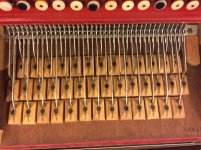Hi all,
Having completed tuning my Maugein 80bass cba (well to my satisfaction anyway), I now would like to re valve as the keys are very noisy. It seems a very simple process on this little box but I am unsure as to how the valves are secured.
It looks like wax but, when I scrape it, it seems too hard for wax. I have enclosed a photo and the little black dots on each valve are leather dots, which I don't see the point of.
Any advice and assistance will be gratefully received. Thanks.
Having completed tuning my Maugein 80bass cba (well to my satisfaction anyway), I now would like to re valve as the keys are very noisy. It seems a very simple process on this little box but I am unsure as to how the valves are secured.
It looks like wax but, when I scrape it, it seems too hard for wax. I have enclosed a photo and the little black dots on each valve are leather dots, which I don't see the point of.
Any advice and assistance will be gratefully received. Thanks.


